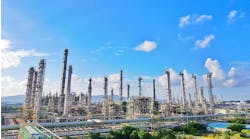Water is a critical utility at process plants, often serving both as a heating and a cooling medium. In this first of two columns about opportunities to cut energy consumption in water systems, we’ll focus on hot water. Many process plants rely on this water for processing and other applications. Providing the water, usually by heating via steam coils or direct steam injection nozzles, takes significant energy. So, here, we will cover five useful tips to cut energy use.
[pullquote]
Tip 1: Recover waste heat, wherever available, to maintain the hot water system. Stack gases at high temperatures, chillers, and air compressor cooling are typical waste-heat sources applicable to the hot water system. In a few cases, deviating from conventional approaches like adding economizers to boilers also may make sense. For instance, a medium-sized chemical plant in Oklahoma, instead of installing an economizer to heat boiler feed water, as was initially recommended, uses the unit to heat the inlet line to the hot water tank. With a lower inlet-water temperature than the boiler feed water, the hot water system recovers more waste heat using the same economizer.
Tip 2: Insulate all bare and exposed hot water piping and tanks. Unfortunately, at too many chemical plants, sizable sections of hot water return lines are left un-insulated. The hot water and condensate return lines only get short lengths of personal-protection-type insulation. When one medium-sized chemical plant was designed 20 years ago with coal as the main fuel, insulation couldn’t be justified for the hot water tank and the return lines. However, when the plant replaced the coal-fired boiler with natural-gas and diesel fired boilers, it left the hot water lines bare.
[javascriptSnippet ]
Tip 3: If steam condensate can’t serve as boiler feed water, use it as hot water. Some plants that fire liquid fuels and heavy oil in their boilers heat the liquid fuel and heavy oil with steam before sending them to the burners, to improve atomization. Usually the condensate from these heaters isn’t returned to the boiler due to worries about contamination but simply is drained to grade. Consider routing this off-spec condensate to the hot water tank catering to wash water demand. The same action applies to condensate drained at tank farms. In a lubrication oil plant at Illinois, we suggested sending the steam condensate to the firewater tank instead of draining it to grade. This firewater tank was heated with steam during the winter months every year.
Tip 4: Replace conventional gas-fired indirect-contact hot water boilers with direct-contact hot water generators. In conventional hot water boilers, the flame and flue gases travel through tubes inside a water drum and finally exit through the stack. These units typically are designed for 85% thermal efficiency. In contrast, the more recently developed hot water generators directly contact water and hot flue gas to transfer the heat, and are designed for 95+% thermal efficiency. These hot water generators are most suitable when no hot water or only a small portion is re-circulated.
Tip 5: Match the hot and warm water needs in the plant with the hot and warm water drains in the plant. Most batch processing operations need hot or warm water for periodic cleaning of equipment and for the shop area. Plants generally heat city water with steam (directly or indirectly) for such washing or cleaning duties. However, hot or warm water drain streams such as blowdown water from boilers and seal water from vacuum pumps could handle such chores. Collecting and routing the hot/warm water drains to the hot water tank would save both heat energy and fresh water addition to the hot water tank. One medium-sized chemical plant used about 40,000 gallons of 170°F water every day for equipment washing and floor cleaning. That same facility drained about 8,000 gallons/day of clear, not turbid, 210°F blowdown water from the boiler to the grade. Because the washing process required only clear hot water, we suggested routing the blowdown water to the wash water tank. The plant implemented this suggestion and saved significant energy.
Hot water isn’t inexpensive. So, consider ways to make fullest use of its heat, and thus cut energy consumption. Next month, we’ll look at some energy-saving tips for cooling water.
VEN V. VENKATESAN is Chemical Processing's Energy Columnist. You can e-mail him at [email protected].


